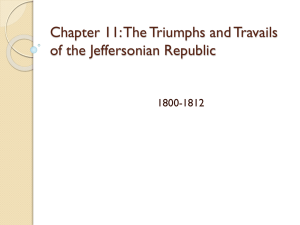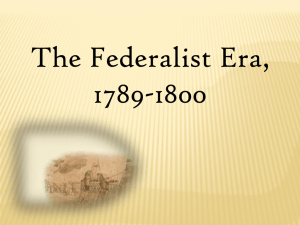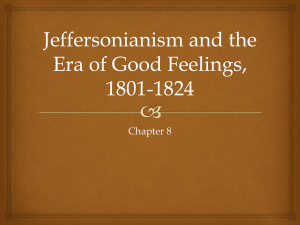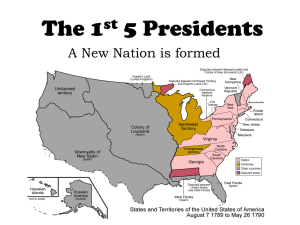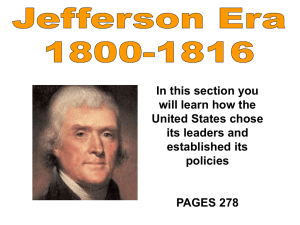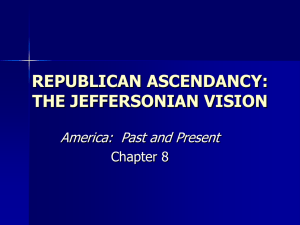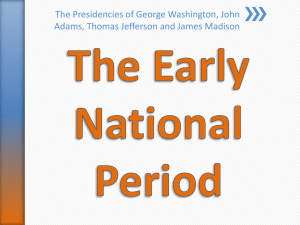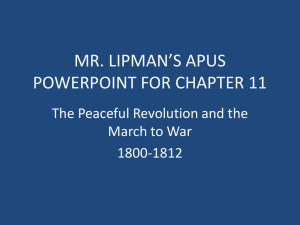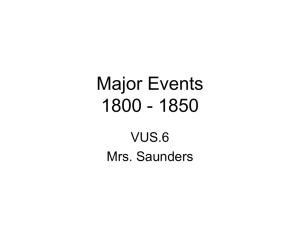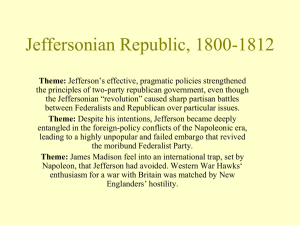File
advertisement
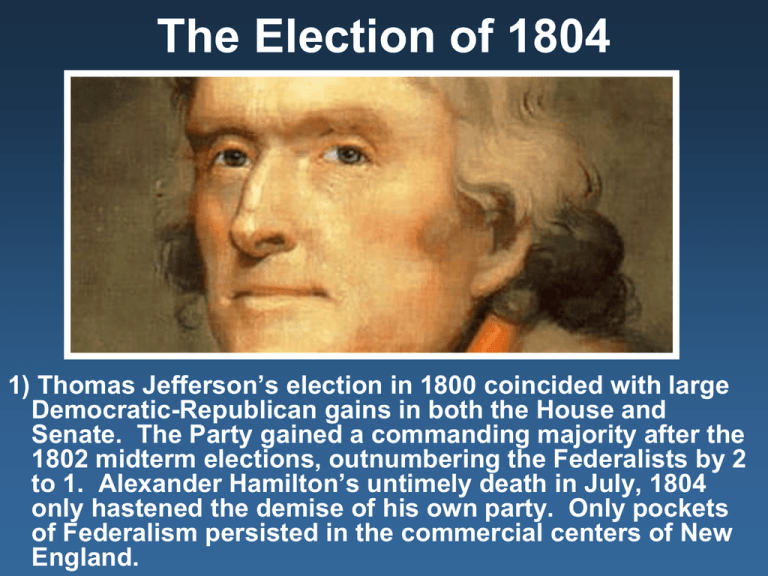
The Election of 1804 1) Thomas Jefferson’s election in 1800 coincided with large Democratic-Republican gains in both the House and Senate. The Party gained a commanding majority after the 1802 midterm elections, outnumbering the Federalists by 2 to 1. Alexander Hamilton’s untimely death in July, 1804 only hastened the demise of his own party. Only pockets of Federalism persisted in the commercial centers of New England. The Election of 1804 2) Historians rank Jefferson’s first term as one of the most successful in Presidential history. Jefferson had doubled the size of the nation with the vast Louisiana territory, maintained peace in the wake of the Napoleonic Wars, retired a substantial portion of the national debt by cutting government spending, and eliminated many taxes inherited from John Adams. The Election of 1804 4) During the election Democratic-Republican journalist James Callender turned his energies against the President and published an account of how Jefferson had previously financed Callender’s scandalous editorials against President Adams. When Jefferson denied the claim, Callender published letters from Jefferson that proved his involvement. Callender turned on Jefferson when the President denied his request to serve as the Postmaster General of Richmond, Virginia. The Election of 1804 5) Democratic-Republicans responded by spreading rumors that Callender had abandoned his wife when she was dying of venereal disease. Callender responded by writing in the Federalist newspaper the Richmond Recorder that Jefferson “keeps and for many years has kept, as his concubine, one of his slaves. Her name is Sally." The Election of 1804 6) Sally Hemmings was a slave at Jefferson’s Monticello plantation and she had several biracial, light-skinned children that looked strikingly similar to their white master. Jefferson had inherited most of his slaves when his fatherin-law, John Wayles died in 1773. It is widely believed that Sally Hemmings was his daughter, making her an illegitimate half-sister to Jefferson’s wife, Martha Wayles Skelton. The Election of 1804 8) Many Jefferson biographers and historians reject the notion as conjecture. A 1998 DNA study proved that there was a genetic link between the Hemmings and Jefferson lines, however, Thomas Jefferson could not conclusively be identified as the father because he did not have a male heir. Historical records reveal that Jefferson was present at Monticello nine months before each of the Hemmings children were born. After a series of further studies, the Thomas Jefferson Foundation that operates Monticello released a statement in 2000 that said, “it is very unlikely that any Jefferson other than Thomas Jefferson was the father of [Hemings' six] children.” Jefferson-Hemmings Descendents at Monticello in 1999 The Aaron Burr Conspiracy VP – 1800-04 1) Thomas VP – 1804-08 Jefferson lost all trust in Vice President Aaron Burr after the election crisis of 1800. Jefferson removed Burr from the DemocraticRepublican ticket during the election of 1804 and replaced him with George Clinton. The Burr Conspiracy 2) Burr’s political isolation led him to switch parties and he ran for the governorship of New York as a Federalist. Burr was sponsored by a group of extremist Federalists that were plotting the future secession of the New England states. Burr made no promises to lead New York into secession, but he never exposed the treasonous conspiracy either. The Burr Conspiracy 3) Alexander Hamilton was alarmed by the radical faction of his own party and he wrote to his wayward allies, “Tell them from ME, at MY request, for God’s sake, to cease these conversations and threatenings about a separation of the Union. It must hang together as long as it can be made to.” Hamilton distrusted Burr and considered him to be the most dangerous politician in the country. They had a long-standing feud that sprouted from their intense rivalry as New York politicians. The Aaron Burr Conspiracy 4) Supposedly Hamilton referred to Burr as “despicable” at a dinner party and his statement was published in the Albany Register newspaper. Hamilton refused to apologize and Burr challenged him to a duel. Just before dawn on July 11th , 1804, the two men were separately rowed across the Hudson River to meet above the cliffs of Weehawken, New Jersey. The Aaron Burr Conspiracy 5) The two men walked twenty paces, turned and faced one another in silence. Hamilton supposedly raised his pistol and fired into the air, a few seconds passed, and Burr took aim and shot Hamilton in the lower abdomen above the right hip. The bullet ricocheted off his false rib and lodged in his spine. Hamilton died the following day and murder indictments were issued for the Vice President of the United States. The Aaron Burr Conspiracy 6) Bur was involved in a secessionist plot by extremist Federalists and killing Alexander Hamilton while he was still the sitting Vice President, Burr also contacted the British Minister (ambassador) to the United States and informed him of his plans to lead a military expedition into the Louisiana Purchase with plans to detach some portion of the Southwestern United States. He accepted $1500 dollars for his plot and requested that the British also provide him with ships. The Aaron Burr Conspiracy 9) Burr was acquitted and he fled to Europe to live in exile until 1812. There are rumors that he even tried to seek audiences with the British monarchy and Napoleon in the hopes of sparking a war on the United States. He eventually returned to America and lived under the alias “Aaron Edwards” in order to escape his creditors and his scandalous past. The Embargo Act (1808) 1) Jefferson’s second term was a considerable disappointment compared to his first four years as President. The same European war that had plagued Washington and Adams now re-emerged under Jefferson. The Embargo Act (1808) 2) After Napoleon secured the purchase of Louisiana, he resumed his bloody war to conquer Europe. This conflict would continue for eleven more years and would continuously threaten American neutrality. The Embargo Act (1808) 3) In 1805, the British were able to destroy the French fleets off the coast of Spain in the Battle of Trafalgar, giving their Navy total control of the high seas. In the Battle of Austerlitz, Napoleon defeated the combined armies of Russia and Austria and took total control of mainland Europe. The Embargo Act (1808) 4) Merchant vessels were being seized and thousands of American sailors were “impressed” into the ranks of the British Navy against their will. The Embargo Act (1808) 6) Instead of war, Jefferson issued the Embargo Act of 1808 in order to cut off all American trade to Europe. Believing that Europe was dependant on American foodstuffs and raw materials, the Embargo would force Britain and France to respect American neutrality. The Embargo Act (1808) 7) The Embargo actually had a crippling economic impact on American shipping long before it was felt overseas. Federalist New England in particular suffered under the constraints of the Embargo. Many shippers turned to illicit trade and smuggling in order to bypass the hated law. The Embargo Act 8) Rampant smuggling led the White House and Congress to increase enforcement by raising fines and issuing harsher penalties, policies that a younger Jefferson would have condemned as tyrannical acts of an intrusive federal government. Congress eventually responded by repealing the Embargo Act in 1809, three days before Jefferson’s retirement. The Embargo Act (1808) 9) The day before James Madison’s inauguration as the 4th President of the United States, Jefferson wrote, “Never did a prisoner, released from his chains, feel such a relief as I shall on shaking off the shackles of power.” Exit Ticket – With a partner • What was the Embargo Act of 1808? (Ex. What countries were involved, what were the results) • Why would a younger Jefferson been disgusted with how his government dealt with the Embargo Act of 1808?
